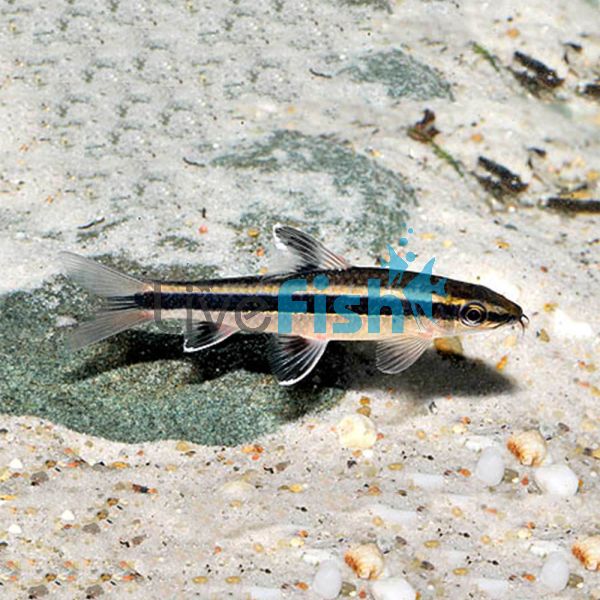Flying Fox 5cm
Flying Fox
The flying fox is often one of the first clean-up crew species that aquarists get for their tank. These fish, when small, are great hair algae eaters and will mature to be an active species for any aquarium. Their hardy nature and constant 'cleaning' make them a popular choice however they are often mixed with a Siamese algae eater due to their looks as juveniles.
The flying fox is still readily purchased despite its bland colour scheme as they make for a discrete addition to aquascapes and planted tanks where the scape is the general highlight. Flying foxes, aside from their algae-eating capabilities, are just an interesting fish to keep. Their shark-like body shape and active behaviour make them unique. Their colours also contrast incredibly well, the jet black horizontal stripes along the golden body with the red flashes to create a beautiful fish. The downturned mouth of flying foxes is perfectly designed for them to skim over surfaces and eat any loose food particles. Whilst as adults these fish aren't great algae eaters, they are still super handy to keep as they will free any detritus settling on surfaces and keep a clean-looking tank.
They are also a hardy and easy to care for tropical aquarium fish, but do get fairly large, maxing out at 14-15 cm which is why they are best for larger planted tanks. Flying foxes are also perfect in a community aquarium setting and are fine with even the smallest of fish as long as they aren't newborn fry or shrimp. Flying foxes are not easy to breed, often requiring specific environmental queues to trigger spawning behaviour. Coupled with this, finding males and females is nearly impossible, as they do not have any clear distinguishing factors. Flying foxes are naturally found in the waterways of Southeast Asia.
Tank Recommendations for your Flying Foxes
Flying foxes max out at around the 15 cm mark and are pretty active, meaning they are not suitable for smaller tanks. The bare minimum would be an aquarium which is 100 litres and has a good footprint due to their fairly active bottom-dwelling nature. The substrate of the aquarium is not a concern for these fish; however, they will love a well-planted aquarium and lots of surface area to graze on. The only precaution that should be taken into consideration for flying foxes is that they are avid jumpers, so a good aquarium lid is a must.
Suitable Tank Buddies
Flying foxes are extremely peaceful fish with no fin-nipping tendencies. They can be kept with a vast range of peaceful community fish.
Usually Compatible
Tetras, gouramis, corydoras, angelfish, cherry barbs, and common community fish species.
Sometime Compatible
Dwarf cichlids, such as rams, and large peaceful cichlids such as Uaru or Severums, which might outcompete for food.
Rarely Compatible
Shrimp and large aggressive species such as African cichlids, Oscars, and Jaguar cichlids.
Feeding your Flying Fox
Though flying foxes are sold for their algae-eating behaviour this is not their only diet. Without added supplementation in their diet, they will begin to starve, which is why they should also be fed a varied diet of pellets, flakes, frozen, and live foods. Because of their primarily bottom-dwelling mentality, a slow-sinking food is best fed to them as this also allows other water column tank mates to eat as well.
| Scientific Name | Epalzeorhynchus kalopterus |
|---|---|
| Care Level | Easy |
| Common Names | Flying fox |
| Diet | Omnivore |
| Fish Family | Cyprinidae |
| Lifespan (years) | 10 |
| Max. Length (cm) | 15 |
| Min. Tank Volume (l) | 100 |
| Origin | South Asia |
| Sociability | Peaceful |
| Venomous | No |
| Water Conditions | 24-28° C, pH 6.50 - 7.5 |




